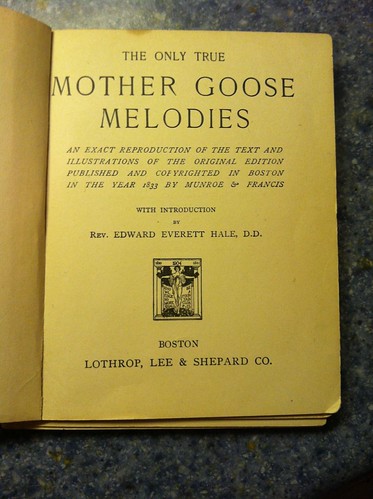(it's really Tuesday but since yesterday was Labor Day, Mother Goose, had the day off!)
Mother Goose is gearing up for the new school year! She is flapping her wings and ready to share all of her rhymes with her new kindergarten friends. Each week she will visit the kindergarten classes to enlighten the little ones with rhymes that they may or may not have heard and recited before.
The first visit is just that - a chance for the children to meet Mother Goose and learn a little bit about her background and history. When I first introduce kindergarten students to Mother Goose, these are the things that I bring:
1. Mother Goose (of course!)
2. My little treasure - an antique mother goose collection that I purchased several years ago in an antique bookshop.

3. A new anthology of nursery rhymes.
4. Humpty Dumpty
4. Humpty Dumpty
Once Mother Goose has been introduced and she gives everyone a "wing flap" (this is equivalent to a wave or high five), I tell the children the story behind Mary Goose, also known as Mother Goose.
We then look at and discuss the antique nursery rhyme collection and compare it to the newer one that has recently been published. Browsing through the two very different nursery rhyme books, we then discover who has a book of nursery rhymes at home.
To complete her visit, Mother Goose, then introduces her first rhyme to the children. We begin by playing a little guessing game with a prop. For this first visit, the usual prop is a simple stuffed Humpty Dumpty character. Luckily, most children recognize the familiar egg and we recite the rhyme together. Nursery rhyme recitation is usually accompanied by motions and movements and sometimes props. For "Humpty Dumpty," we use our fist as an egg, our opposite arm as the wall, and a gallop with clippity cloppety sounds for the horse.
Mother Goose and I locate the rhyme in one or more nursery rhyme books and discuss the different styles that illustrators have used to create their rendition of the rhyme. Before we leave, I leave the students with a printed copy of the rhyme and sometimes various other rhyme extension activities.
On our way out of the classroom, Mother Goose and I give a "wing flap" to the students and they give a "wing flap" to Mother Goose! Until next time . . .
We then look at and discuss the antique nursery rhyme collection and compare it to the newer one that has recently been published. Browsing through the two very different nursery rhyme books, we then discover who has a book of nursery rhymes at home.
To complete her visit, Mother Goose, then introduces her first rhyme to the children. We begin by playing a little guessing game with a prop. For this first visit, the usual prop is a simple stuffed Humpty Dumpty character. Luckily, most children recognize the familiar egg and we recite the rhyme together. Nursery rhyme recitation is usually accompanied by motions and movements and sometimes props. For "Humpty Dumpty," we use our fist as an egg, our opposite arm as the wall, and a gallop with clippity cloppety sounds for the horse.
Mother Goose and I locate the rhyme in one or more nursery rhyme books and discuss the different styles that illustrators have used to create their rendition of the rhyme. Before we leave, I leave the students with a printed copy of the rhyme and sometimes various other rhyme extension activities.
On our way out of the classroom, Mother Goose and I give a "wing flap" to the students and they give a "wing flap" to Mother Goose! Until next time . . .
No comments:
Post a Comment